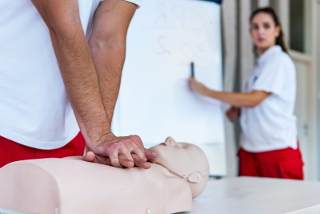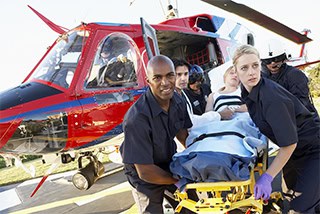How to Become an EMT or Paramedic: A 10-Step Guide to Success
Are you eager for a challenging career that lets you save lives? If so, it's time you learned how to become an EMT or paramedic. This comprehensive guide explains everything you need to do in order to become fully qualified as a provider of out-of-hospital emergency medical care.
The specifics vary a bit from state to state. But generally speaking, to become an EMT or paramedic, you need to finish high school, complete an approved training program in emergency medical technology, pass the national certification exams, and get a license from your state. As part of that process, you will have to become certified in CPR and pass both a health screening and background check. Each step is outlined in more detail below.
Once you have your state license, you can enjoy the pride and sense of purpose that comes from assisting victims of natural disasters, car accidents, heart attacks, sports injuries, and other life- or limb-endangering incidents. You can also take advantage of rapidly expanding opportunities with hospitals, private ambulance services, fire departments, and air rescue crews. In fact, the Bureau of Labor Statistics says employment of EMTs and paramedics is expected to expand by six percent nationwide over the decade between 2023 and 2033. On average, more than 19,200 jobs should become available each year over that time period.
So read on to discover the 10 key steps to becoming an emergency health professional!
- Understand the difference between a paramedic and an EMT
- Get your high school diploma or GED
- Seek out relevant experience (optional)
- Become certified in CPR
- Maintain a valid driver's license
- Meet all medical requirements
- Pass a criminal background check
- Complete a training program
- Obtain national certification
- Get licensed by your state
1. Understand the difference between a paramedic and an EMT
While EMTs and paramedics both provide essential care to sick and injured people and transport them to hospital when necessary, there are important differences between these two roles in terms of the training they require and the types of tasks they can perform.
Emergency medical technicians (EMTs) provide a basic level of life support. They can assess vital signs, perform cardiopulmonary resuscitation (CPR), administer oxygen, bandage wounds, treat burns, and stabilize fractures. In most states, basic EMTs (known as EMT-Bs or EMT-1s) are not authorized to provide treatments that involve breaking the skin. That means they do not start IVs or give shots. However, they are usually permitted to administer auto-injectors in order to deal with allergic reactions. Training courses for basic EMTs are typically 120 to 200 hours long. It can take anywhere from a few weeks to a few months to become an EMT, depending on how often classes are held.
Some states have EMT-Intermediates (EMT-Is) or Advanced EMTs (AEMTs) who complete additional training that allows them to carry out tasks like setting up IVs and administering certain medications.
Paramedics provide the highest level of emergency care outside of a hospital. They can do all the same things EMTs can, plus they can stitch up wounds, interpret EKGs, insert breathing tubes, perform manual defibrillation, and administer a wide range of medications. Paramedic programs are usually 1,200 to 1,800 hours long and typically result in an associate degree. It's important to note that you must be certified as an EMT before you can become a paramedic.
2. Get your high school diploma or GED
Completing high school is a key step. Most training programs require applicants to have a high school diploma or equivalent.
When choosing your classes, aim for a well-rounded education. Science courses that focus on the functioning of the human body, such as biology or anatomy, are obviously useful. So are math courses, since paramedics need to be able to quickly calculate medication dosages in their head. Psychology classes can also be beneficial because they can help you understand the mental state of your patients.
And don't forget about physical education. EMTs and paramedics often have to lift immobilized patients or restrain distraught people in order to keep them from harming themselves, so it's important to be flexible and strong. You should be able to lift and carry 100 pounds or more.
3. Seek out relevant experience (optional)
 If you want to get early experience that involves handling medical emergencies, consider becoming a lifeguard. In this role, you are responsible for providing emergency aid to swimmers in distress. Lifeguard training is available to candidates as young as 15 and commonly includes instruction in first aid and CPR, both of which will serve you well as an EMT.
If you want to get early experience that involves handling medical emergencies, consider becoming a lifeguard. In this role, you are responsible for providing emergency aid to swimmers in distress. Lifeguard training is available to candidates as young as 15 and commonly includes instruction in first aid and CPR, both of which will serve you well as an EMT.
Even before you become an EMT yourself, you can get an inside look at what's involved in the career. Many ambulance services and fire departments have special programs that allow interested students to ride along in order to observe emergency personnel in action. Each agency sets its own rules, but you generally must be at least 16 or 18 to participate. You must also sign a liability waiver and agree to maintain the confidentiality of all patients you observe. You should have a professional appearance and dress appropriately: Dark pants (not jeans), a plain white collared shirt, and sturdy work shoes are typically required. During your ride-along, follow all crew instructions and don't interfere with their duties. This is a great opportunity for you to get a real sense of what EMTs deal with every day.
4. Become certified in CPR
Some EMT programs include CPR training as part of their curriculum, but others expect you to be certified before applying. If the onus is on you, check with your state licensing authority or the training institution you plan to attend to see if there is a specific course provider you should use.
CPR training is part of Basic Life Support (BLS) courses for healthcare providers. Here are a few examples of organizations that offer such courses:
5. Maintain a valid driver's license
A driver's license is not always required to train as an EMT, but most employers prefer candidates who have one. A valid license is often required for paramedic training. Each emergency services agency sets its own rules about what constitutes an acceptable driving record, but it's a good idea to try to keep yours as clean as possible.
Once you complete the EMT training, certification, and licensing procedures, you can take a specialized one- to two-day course in order to learn the necessary skills for driving an ambulance.
6. Meet all medical requirements
Many training programs require applicants to attest that they are healthy enough to handle the clinical components of the course. This typically means undergoing a physical exam so that a healthcare professional can certify that you do not have any limitations that would prevent you from fulfilling the requirements of your program.
Usually, you must also provide proof of immunizations for Hepatitis B; measles, mumps, and rubella; and varicella. You may also have to get a tetanus booster and pass a drug or tuberculosis screening. Plus, many programs mandate that students provide proof of health insurance.
7. Pass a background check
Some training programs require this as part of the admissions process. In addition, a check is typically performed when you apply for state licensure or employment. You may be required to provide fingerprints.
Having a criminal record will not necessarily preclude you from becoming an EMT. Each state decides what crimes are serious enough to deny licensing. Some are willing to accept candidates with a criminal history if the offense occurred a long time ago and the candidates can provide reference letters from therapists or probation officers.
You will be required to disclose any criminal convictions when you apply for national certification. You may be ineligible for certification if you have been convicted of felonies or misdemeanors involving sexual assault or abuse, dangerous weapons, physical assault, theft or burglary, or abuse of children, the elderly, or the infirm.
If you have any doubts about your status, review your background with an advisor at your training institution and ask how likely it is that you will qualify for a license.
8. Complete a training program
 To be an EMT, you must complete a state-approved educational program in emergency medical technology. Community colleges, vocational schools, and technical institutes offer short EMT programs that include a mix of classroom study and hands-on training in the lab and in the field.
To be an EMT, you must complete a state-approved educational program in emergency medical technology. Community colleges, vocational schools, and technical institutes offer short EMT programs that include a mix of classroom study and hands-on training in the lab and in the field.
You generally must be at least 18 years old to enroll in an EMT program. In some states, special programs allow high school students as young as 16 to complete basic EMT training.
You must complete your EMT training and become certified before you can take the additional training to become a paramedic. Some paramedic training programs require a certain amount of EMT work experience. And in the state of Washington, you must hold EMT certification for at least a year before you can pursue paramedic training.
In some areas, associate degree programs include the full range of training, from EMT up to paramedic. In order to qualify for AEMT- or paramedic-level courses, you must first acquire your EMT certification. You don't usually need any work experience, though.
The cost of becoming an EMT varies widely depending on the program you choose and the type of institution you attend. Tuition can range from less than $1,000 to more than $10,000. Training for higher-level positions such as Advanced EMT and paramedic is more involved and thus costs more than training to become a basic EMT.
Here are some other expenses you may need to budget for. (These figures are estimates only; contact your training institution for specific details.)
- Textbooks: $150 to $500 or more
- Uniform (pants, polo shirt, boots): $100 to $300
- Stethoscope: $20 to $75
- Background check and drug screening: $60 to $100
- Physical and immunizations: varies depending on your healthcare plan
- CPR certification for healthcare providers: $40 to $85
- Application fees for the NREMT cognitive exams (see below): $80 to $125
- State licensing: $80 to $200
9. Obtain national certification
Most states require prospective EMTs and paramedics to be certified by the National Registry of Emergency Medical Technicians (NREMT) to qualify for a state license. As of 2019, there is no longer an age requirement for NREMT certifications. The National Registry now defers to state-specific age requirements. The process involves passing both a cognitive (knowledge) exam and a psychomotor (skills) exam.
Becoming certified as an EMT
The cognitive exam has between 70 and 120 multiple-choice questions. Ten of the questions do not count toward your final score, but you won't know which ones those are. The exam is a computer-adaptive test, which means the questions you receive are tailored to your ability level based on your responses (i.e., the more correct answers you give, the harder the questions get).
There are two key things to know about a computer-adaptive test: (1) There is one "best" answer (even if all of them look right or all of them look wrong), and (2) you can't change an answer once you give it. So it's important to read each question carefully and consider your response.
To pass, you must demonstrate entry-level proficiency in five areas:
- Medical, obstetrics, and gynecology
- Cardiology and resuscitation
- Airway, respiration, and ventilation
- Trauma
- EMS operations
If you don't pass the first time, you get two more opportunities to re-take the test, but you must wait 15 days between attempts. If you are still unsuccessful after three tries, you must take remedial training.
The psychomotor exam evaluates your practical abilities in areas like patient assessment, bleeding control, spinal immobilization, and cardiac arrest management during simulated encounters with injured people. At the basic EMT level, psychomotor exams are run by state EMS offices rather than the NREMT. However, the NREMT does offer skill sheets that list the tasks you will be expected to perform. The skill sheets also outline the actions that result in an automatic fail for that test, so be sure to review those in detail when you are preparing for the exam.
You may also find it helpful to watch online videos that show candidates carrying out the test so that you can get a better understanding of what to expect on exam day. For example, check out these videos on joint immobilization and bag-valve-mask ventilation.
Becoming certified as an Advanced EMT
You must hold EMT certification and complete an Advanced EMT training program before you can be certified at this level. The cognitive exam for the Advanced EMT is a straightforward linear test with 135 questions, 35 of which do not affect your final score. It covers the same five areas as the basic EMT exam. The psychomotor exam tests your hands-on skills in areas such as establishing IVs and inserting advanced airway devices.
Becoming certified as a paramedic
You must be certified as an EMT (though not necessarily an Advanced EMT) in order to be certified as a paramedic. You must also successfully complete a paramedic training program that has been:
- accredited by the Commission on Accreditation of Allied Health Education Programs (CAAHEP); or
- issued a "letter of review" by the Committee on Accreditation of Educational Programs for the Emergency Medical Services Professions (CoAEMSP).
Like the cognitive test for basic EMTs, the cognitive exam for paramedics is a computer-adaptive test. This one uses 80 to 150 multiple-choice questions, including 20 that you won't actually be assessed on.
The psychomotor exam includes a scenario-based test of your ability to manage a patient, a scene, and a team. Working with a trained partner, you will demonstrate your skills in trauma patient assessment, cardiac arrest management, EKG interpretation, and more. You will also be evaluated on your interpersonal skills, so it's critical to behave professionally toward both your patients and your partner.
10. Get licensed by your state
Certification alone does not authorize you to work as an EMT or paramedic. You still need to get a state license. However, licensing requirements vary from state to state. Being certified by the NREMT is usually enough, but a few states require you to pass a state-specific exam.
EMTs and paramedics must recertify regularly, typically every two to three years. Check with your state EMS agency for details.
Train to Save Lives
You've learned how to become an EMT or paramedic, so now it's time to focus on getting the training you need to start enjoying a fulfilling career in pre-hospital emergency care. Relevant, focused programs are widely available at trade schools and vocational colleges. And finding such schools in your area is a simple matter of putting your zip code into the search tool below. Try it right now!





